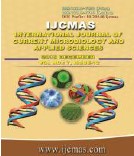


 National Academy of Agricultural Sciences (NAAS)
National Academy of Agricultural Sciences (NAAS)

|
PRINT ISSN : 2319-7692
Online ISSN : 2319-7706 Issues : 12 per year Publisher : Excellent Publishers Email : editorijcmas@gmail.com / submit@ijcmas.com Editor-in-chief: Dr.M.Prakash Index Copernicus ICV 2018: 95.39 NAAS RATING 2020: 5.38 |
A field experiment was conducted during kharif 2017 to study the “Nitrogen management through different decision support tools in Direct Seeded Rice (Oryza sativa L.) under Tungabhadra Project (TBP) command area of Karnataka” at Agricultural Research Station, Gangavathi. The soil type in the experimental site was medium black soil with soil pH and EC of 7.90 and 0.43 respectively. The initial soil available nitrogen, phosphorus and potassium was 213.2, 31.05 and 374.8 kg ha-1, respectively which is in the range of low in nitrogen, medium in phosphorous and high in potassium content. The experiment consists of 12 treatments laid out in randomized block design with three replications. The results revealed that application of nitrogen through LCC ≤ 6.0 threshold recorded significantly higher N, P and K uptake at harvest (184.2, 35.2 and 137.8 kg ha-1, respectively), which was on par with LCC ≤ 5.0 threshold (178.6, 32.0 and 135.9 kg ha-1, respectively), SPAD ≤ 40 (164.0, 30.6 and 134.6 kg ha-1, respectively), SPAD ≤ 50 (171.2, 31.1 and 135.1 kg ha-1, respectively), Green Seeker ≤ 0.8 (156.7, 30.1 and 133.8 kg ha-1, respectively) as compared to RDF (93.2, 24.1 and 125.4 kg ha-1, respectively) and farmers practice (112.7, 25.8 and 129.6 kg ha-1, respectively). Similar trend was also observed in economic. Whereas the application of nitrogen through LCC ≤ 4.0 threshold recorded significantly higher Agronomic efficiency, Recovery efficiency and Partial factor productivity (38.57 kg kg-1, 98.33% and 76.73 kg grain kg N-1, respectively), as compare to other treatments. Hence, precision nitrogen management in DSR can be done through LCC ≤ 5.0 or SPAD ≤ 50 and green seeker ≤ 0.8 threshold for obtaining nutrient uptake and economics.
 |
 |
 |
 |
 |